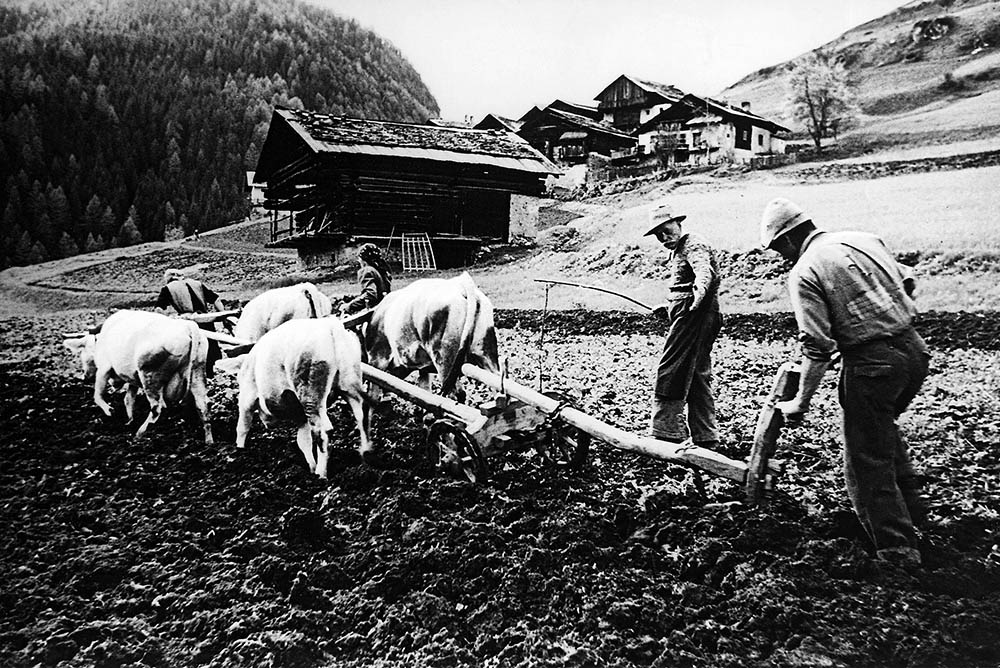A vertical history
The colonisation of the valleys in the Alps, the border between the Latin and the German world, the evolution of a “connective” culture, the living, the traditions, the epic.
The history of the Dolomites can be read in the transformations of the landscape that are connected to the presence of the human being. Starting from the first presence of the human being (10,000 b.C.) and from the sedentary settlements (Bronze Age), the human being tried to adapt the habitat to his needs; however, the changes of the natural landscape could only be noticed starting from the first half of the 1st millennium. At that time, Celtic and Rhaetic populations built the first sedentary settlements and the first organized net of paths and communication passes between Middle and Northern Europe and Southern Europe.
The contact with the native (mostly Rhaetic) and the Roman populations led to the development of a new culture and of a new language, the so-called Rhaeto-Roman language. This culture, mostly oral and rural, conveyed to the landscape shapes that can still be observed, combining the ability to organize and manage the territory, typical of the Latin population, and the knowledges about agriculture in the Alps of the Rheatic populations: the “vìles” represent an original and unique model of settlement.
Although the Dolomites were crossed by the Italian-German linguistic border, the Ladin culture resisted and strengthened in the internal and less crowded parts. Its elements can be observed in the landscape and in the buildings (simple, with wood or stones, barns and stalls).
The discovery of the Dolomites: the first explorations, the evolution of scientific theories, Dolomieu, von Buch, von Humbolt, Mojsisovich.
In the 18th century, the Dolomites were unknown and far from the most important commercial ways; only few places of this area were known. At that time, the economy consisted of agricultural, farming and woodland activities. It was a subsistence agriculture, characterized by seasonality. The few alternatives were the wood crafts and some mining activities. The first explorations were strictly connected to the mining research, which was carried out by G.Arduino (1714-1795), mining inspector of the Republic of Venice.
The French scientist Déodat de Dolomieu (1750-1801) gave the most important impulse to the knowledge of the Dolomites. He sampled for the first time, close to the village of Salorno (Salurn), rocks that contained a calcium carbonate that was not very reactive to the acid. This carbonate was called dolomite, in the name of this French scientist.
Because of all the people crossing this area, a welcome net was developed (inns, guides); on this basis, the real touristic activities started.
At the beginning of the 19th century, the scientists A.F. von Humboldt (1769-1859) and C.L. von Buch (1774-1853), who were in the village of Predazzo to examine the surrounding rocks, brought into question the Neptunism theory, in favour of the Plutonism, which was then confirmed by the naturist G. Marzari Pencati (1779-1836), thanks to the observations in the quarry of Canzoccoli.
In the first half of the 19th century, the contribution of several geologists (T.A. Catullo, 1782-1869; G.G. von Münster, 1176-1844, A. Stoppani, 1824-1891) clarified the organic origin of the mountains of the Dolomites, describing the marine faunas of the Triassic and determining the primary role of sponges and corals in the formation of carbonate atolls in the Triassic. F. von Richthofen (1833-1905) interpreted the atolls of the Dolomites as the fossils related to the actual coral reefs of the tropical seas and produced some geological schemes for some of them.
After 1850, some travellers were curious to see “the glimmering of the pale pinnacles of the Dolomites” and explorers looked for adventure on the “inviolate peaks” and in the “unexplored valleys”.
Towards the end of the 19th century, other important paleontological studies described the Permian and Triassic faunas, consisting of ammonites. M.O. Gordon (1864-1939) plaid an important role in the comprehension of the relationships among fossil atolls, sedimentary basins and Vulcans of the Triassic. She was the first woman who got a PhD in Earth sciences.
After the first alpinist exploits, the number of climbs increased thanks to local guides and to foreign alpinists (German, Austrian and English). Thanks to this exploits, the most important Alpine Clubs of Europe were built.
In the 20th century, the Dolomites became scientifically more important, and researchers came from the entire World to study and propose reference models for Earth sciences. However, the 1st World War suddenly stopped this flourishing period and negatively marked the economic development of local communities.
The Great War.
During the World War, there was a 250 Km front through the Dolomites between May 1915 and October 1917. The tactical choices of both formations led to a position war that required a great logistic engagement to guarantee the connection with the main communication ways.
During the conflict, the landscape of the valleys was transformed through infrastructures that are still present. Several roads suitable for vehicles and some narrow-gauge railways (Val Gardena, Valle di Fiemme, val di Landro and del Boite) were constructed; in this way, lateral valleys were reachable and the territory of the Dolomites was accessible.
The skyline of the Dolomites was modified as well. The first lines by the peaks and the crests were fortified with tunnels, trenches and underground passages; they were long (several kilometres) and excavated with a jackhammer or with mines. Just before them, cableways were built in order to reach the highest peaks. Several mule tracks and military roads were constructed as well, which are still working. Through them, the main groups of the Dolomites could be reached (Dolomiti di Sesto, Marmolada, Tofane).
Water systems, electrical and telephone lines and radio stations were constructed, in order to supply the outposts. On the glaciers, battles took place: the net of tunnels, posts and camps that was excavated in the Marmolada was so extended and big, that it was called “the city made of ice”.
Organized tourism, communication ways, the transformation of the economy, mass tourism.
As far as the landscape in concerned, the period between 1920 and 1950 is not significant, because the advantages brought by tourism were important only for touristic places, which had infrastructures and services. However, in this period people started to do downhill skiing and Nordic skiing, doubling the possibilities to improve the economy and the social wealth.
After 1950, mass tourism started to spread, and settlement and culture started to change. Furthermore, the production system changed from a rural to an industrial one. However, the touristic development did not affect regularly the area of the Dolomites. This kind of development occurred only in the areas that were closed to the communication ways and above all in the bottom of the valley.
Cesare Micheletti
[Translation by Sara Covelli]
credits:
foto2: Aratura di un campo in Val di Fassa. Fine ‘800 – Crediti fotografici Cierre Edizioni
Archivio Cierre Edizioni




